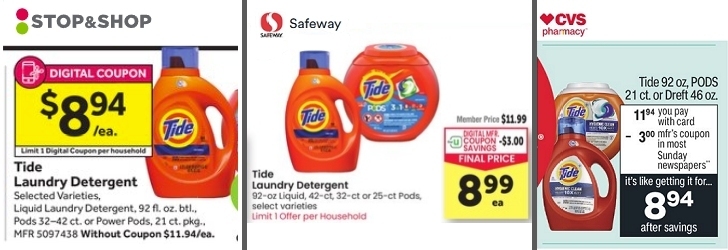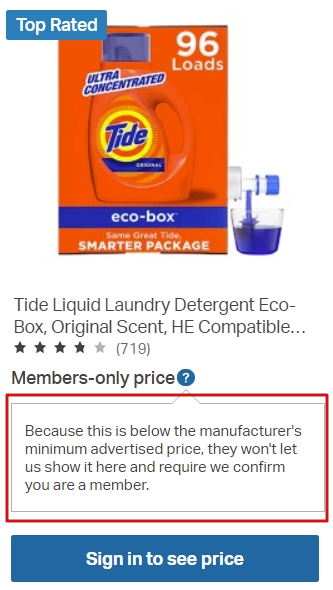 This week we reveal a dirty little secret in the grocery business.
This week we reveal a dirty little secret in the grocery business.
We’re in the midst of a nasty period of inflation putting pressure on many families’ grocery budgets. But in some cases, the problem is being exacerbated because of a little-known manufacturers’ policy that prevents stores from deep discounting certain products.
First, a little history. When MrConsumer was a teenager, he remembers going to wholesale showrooms with his mother to buy Corning Ware at 40% off. You could not get a discount at retail stores in New York because that brand was “fair-traded” — meaning that it had to be sold at full retail price.
Those days are gone, but the concept lives on in modified form under the retail concept called “resale price maintenance” (RPM). For years, high-end products like Sony, Apple, or Bose commanded (and still command) premium prices and are rarely advertised at deep discount. These brands are likely subject to “MAP” — minimum advertised prices. That is a related pricing scheme allowed by federal antitrust law [see pages 3-7] that permits a manufacturer to unilaterally “announce” the lowest price at which it will allow its products to be advertised. Retailers who violate “MAP” could lose out on advertising funding (co-op ad dollars) or be cut off as a distributor of the brand. However, mandatory minimum pricing contracts between manufacturers and retailers while no longer per se illegal, risk legal challenge.
In many court cases, MAP was justified in part because it was applied to sophisticated products that required salespeople at department stores to educate shoppers about the benefits of the particular brand, and the employment and training of these workers was a costly proposition. MAP gave retailers more margin to afford those extra expenses.
MrConsumer has long suspected that MAP had crept into the grocery business, where supermarkets were expected not to advertise certain famous brand products below a floor set by the manufacturer and certainly not be used as a loss leader to build store traffic.
Take this example of regular liquid Tide in the 92 oz. bottle. During early November, checking some supermarket and retail ads around the country, the price was never advertised below $11.95 (give or take a few pennies) except when it typically came with a retailer-supplied manufacturer’s $3 off coupon offered directly to customers. In that case, the price was never advertised below $8.95.


How is it that all these independent sellers serving different parts of the country have identical sale prices and not one of them is lower? They are certainly not allowed to conspire with each other. So Tide had to be subject to MAP, I speculated. But how to prove it? Then along came Sam’s Club with the smoking gun.
*MOUSE PRINT:

There it was in black and white — Sam’s Club disclosed that Procter & Gamble, Tide’s manufacturer, had prevented it from advertising their price for this Tide product (a warehouse size) because their price was lower than the minimum price they were allowed to promote.
Gotcha!
We wrote to P&G to confirm this, and asked some very pointed questions. How do they justify applying MAP to grocery items (since there are no high-priced salespeople in store aisles needed to educate shoppers)? What other P&G products are subject to MAP? How common is MAP in the grocery business? And much more.
P&G has not responded despite multiple requests.
We believe that Tide and P&G are just the tip of the iceberg. The question is which other major consumer products manufacturers are preventing retailers from advertising deep discounts on grocery products at a time when shoppers’ budgets are being increasingly strained by inflation?
What are your thoughts? Should manufacturers be able to dictate sale prices to stores thus limiting discounts?

I hope they get sued. Not responding to your questions sure makes me believe they are guilty.
I don’t think manufacturers should be able to determine store discounts. Leave that up to the store itself as discounts are used to attract more customers. Although I have not bought P&G products in several years, I’m sure they are not the only ones doing this.
I am curious what you buy instead of P & G products? Considering their products/brands make up most of the non-food items that most consumers use.
Persil, store brand dryer sheets, Clorox, Dove soaps, Nivea body wash. I stay away from P&G because of their deep dive into woke everything. I don’t need to be told by anyone in the product business how men/women & children should behave & act and what they should accept. P&G gets none of my money.
In addition to JG’s reply below I use Colgate/Palmolive, Avon, Revlon, Unilever products, Bic, Church & Dwight just to name a few. I always look at the labels. No P&G products go in my cart.
If the FTC was really working for the public this would not be happening. Truth is is happens with many companies. A government buy the people, for the people, could make life so much more pleasant. Case in point, robocalls. what is the government really doing for us. All talk, no action.
Anyone on a budget, as am I, would have been buying discount/store brand detergents, such as Xtra, for years, and not high-priced Tide. This goes for all products across all the grocery aisles. We still have choices at the store, in battling inflation (at least for now). NOW, let us try to apply that to the gas buying game, where there isn’t a penny or few difference from station to station to station, shall we? NO price-fixing there! Yuk-Yuk-Yuk.
If you’re a serious shopper, as I have been for decades, you know that price-fixing is rampant and obvious. Not only are prices fixed across the board, there are shelf fees that place products in shopper’s faces and lesser brands on lower or higher shelves.
This has been going on, unimpeded, for years. The consumer has been paying a very steep price (literally) for products, and coupons and discounts don’t always help, and are disappearing now, when we need them the most.
Consumers have to make these companies understand the value of our hard-earned dollars. The only way to make them totally understand and value us, is to withhold our money until changes are made. Don’t buy the products that are price-fixed.
OMG! I’m so glad to here someone else finally say the same thing. They are going to keep doing it until we stop them and the way to stop them is withhold the money. People need to realize that they don’t have to have a lot of the stuff that they overpay for. No one really has to have Oreo cookies or any of the other hundreds of overpriced items we think we can’t live without. Stop helping the rich get richer at our expense.
I’m in favor of the government, for the most part, staying away from as much as possible.
Just not gas prices. Or watch a big red wave in 2022.
I hope you get a response from them although I highly doubt it.